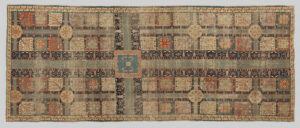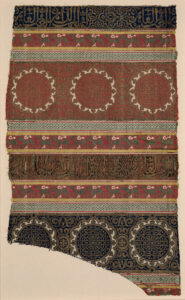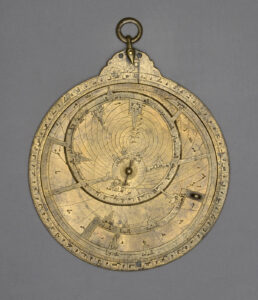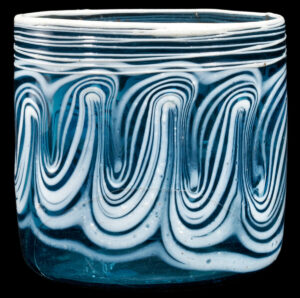Textiles are one of the most diverse types of objects from the Islamic lands. They include some of the most valuable and refined luxury goods produced, highly prized by their owners at the time and among the most prestigious diplomatic gifts and rewards for service at court. Egypt, Iran, Turkey and India produced some of the most spectacular woven textiles for garments and cushions, using silk and metal threads to luxurious effect in figural as well as calligraphic, floral and other designs.
In the early mediaeval period, Egypt was famous for ‘tiraz’ textiles, a series of types which incorporated inscription bands. Whether integrally woven, embroidered or written with pen and ink, these inscriptions generally took the form of fine calligraphy and often included the name of the Caliph and the factory (tiraz) in which they were produced.
Knotted pile carpets have a history in Asia which goes back beyond the fourth century BC. The Iranian lands and Turkey are justly famous for their production of carpets, with The al-Sabah Collection holding some two dozen fragments of 2nd – 4th centuries carpets from the region. These are in addition to many examples from later Islamic centuries. Thr distinctive ‘Mamluk’ carpets from 15th and early 16th centuries CE, Cairo are also well represented in the collection.

Linen, silk and silver wire textile fragment with affronted birds, human face, hares, rosettes

Fragmentary multiple-niche pile prayer carpet (saff) with floral and palmette arabesques

Cotton shawl embroidered with vegetal designs and Persian lament mentioning Bamyan

Pile carpet with chahar bagh layout, flowering trees, flower beds, pond with peacocks

Fragmentary silk textile with naskhi inscriptions, quadrupeds, guilloches, medallions

The al-Sabah Collection contains almost two thousand items of metalwork ranging from elaborately worked vessels inlaid with precious metals to simply cast bronze finials in the form of animals. Islamic metalworkers, whether in Cairo or Herat, often fashioned relatively simple

The al-Sabah Collection is rich in manuscripts of the Qur’an. These range from a double page folio from one of the earliest known manuscripts, copied in the second century of Islam in a distinctive vertical script known as Hijazi, to

Glass objects in the collection date back almost 4,500 years and include objects from virtually every period since. The depth of the glass objects in The al-Sabah Collection allows both scholars and visitors to study, understand and appreciate the evolution